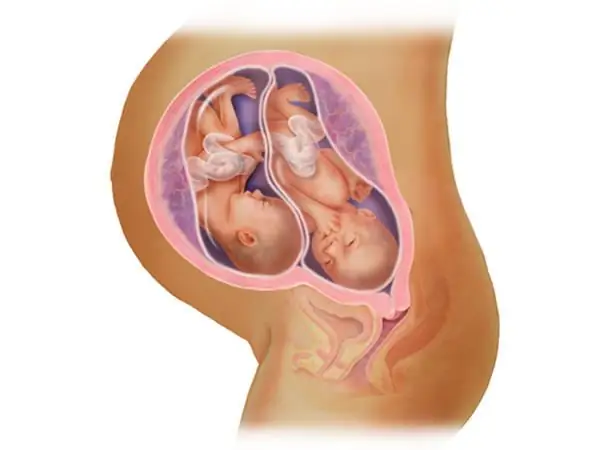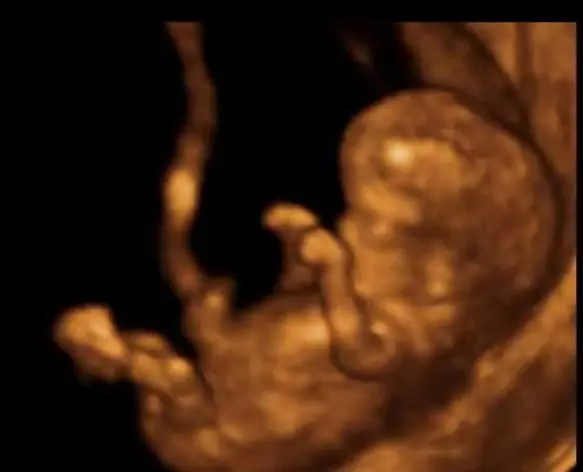2025 Author: Priscilla Miln | [email protected]. Last modified: 2025-06-01 05:14:29
For any future mother, it is necessary to be sure that her baby is developing correctly, without various deviations and disorders. Therefore, after the first ultrasound examination, a pregnant woman learns about such a concept as fetometry of the fetus by weeks. Thanks to this type of ultrasound examination, you can find out the dimensions of the body parts of the fetus, make sure that the gestational age set by the doctors is correct and see possible deviations in the dynamics of the child's development.

The main task of fetometry of the fetus
1. After this research method, doctors and the expectant mother will be able to verify the proper level of fetal development, for example, to clarify the size of the fetus, which is 5 weeks old.
2. After 20 weeks, you can determine the gender of the unborn baby.
3. Thanks to the first ultrasound, you will be able to contemplate the "first smile" of your baby andfix his movement.
Characteristics of the main indicators of diagnosis

Fetometry week by week allows specialists to verify the correct development of the child. The first ultrasound examination has the following indicators:
- KTP (coccygeal-parietal size) is typical for short periods of pregnancy, when the fetus has not yet reached a size of 20-60 mm.
- BDP (biparietal size) - this indicator is associated with the second trimester of pregnancy and provides an opportunity to know its term with an accuracy of 10 days.
- DB (measuring the length of the thigh) also makes it possible to estimate the gestational age, but the accuracy is somewhat less - up to two weeks. This research option is used when the previous measurement cannot be brought to a satisfactory standard.
- OB (abdominal circumference) - a characteristic that is already aimed at studying the development of the fetus. After all, now it is possible to visualize a short segment of the umbilical vein, the fetal stomach, the gallbladder and, of course, the venous duct. Therefore, such a concept as fetometry of the fetus by weeks is very relevant in the process of assessing the growth of a baby. At the same time, it is important to follow a small recommendation - such a measurement cannot be carried out when the fetus weighs more than 4 kg.
- CG (chest volume) provides an opportunity for specialists to estimate the gestational age at 14-22 weeks.
Specialists insist that in order to obtain more reliable information, ultrasound is necessarycarry out in a complex, in other words, simultaneously. So, the concept of fetal fetometry by weeks for up to 36 weeks is characterized by such studies for pregnant women as OB, BPR and DB. After reaching this period, pay attention to the coolant, OG and DB.
But here you should not take everything as a law. Since it is necessary to look closely at the individual characteristics of the development of the fetus and possible delays.
How to independently understand the reading of the conclusion of fetometry studies

Fetometry week by week is really of great importance for doctors and parents of the unborn child. But not everyone will be able to independently understand the conclusion of specialists in the absence of a special higher medical education.
In order to find out the expected date of birth of your child, you should pay attention to the obstetric gestational age. This date is easily calculated thanks to the information about the first day of the last menstrual cycle. In this case, it is imperative to take into account those indicators that were obtained after the fetometry. Although in this case, different interpretations of the same indicator are possible.
The simplest algorithm for reading an ultrasound report

1. By knowing the first day of your last period or the day of conception, you can calculate your baby's approximate date of birth.
2. You can verify the correctness of the calculation (from the first paragraph) based on the indicators of ultrasound examinations 1 or 2trimester.
3. Information about the percentage of characteristics for DG, BPR, J.
4. The study of the probable intrauterine growth retardation of the fetus.
Fetal Fetometry Chart
Today, fetometry is of great importance for pregnant women. The table of such an ultrasound examination indicates the main indicators of the normal development of the baby and is available to any doctor who deals with obstetrics and gynecology. Therefore, future mothers will be able to calmly control the process of "growing up" of their child in the womb. But for this it is necessary to correctly identify the exact gestational age. And this is possible only after analyzing the readings of the fetometry table.
In order to find out the preliminary date of birth of your long-awaited child, you need to calculate the available data using the Negele formula. So, to the date of the last menstruation, you need to add a week, and then subtract three months.
But still, in order to verify the accuracy of such calculations, it is also necessary to take into account the results of an ultrasound examination. Although even in this case errors are possible. Since the diagnostic equipment of medical institutions may be inaccurate. So the fetometry of the fetus, the table of which is considered the main reference point in the process of ultrasound examination, is somewhat relative. After all, it also has its variations.

Don't worry too much about that. After all, the differences are insignificant and cannot greatly affect the overall result.
Fetometry by week, tablewhich has indicators of the development of the baby, can be very useful not only for the expectant mother, but also for doctors.
Although in this case it should be understood that all characteristics are given in the average value. This is all due to the fact that all children have different weight, height and other parameters. And therefore, for greater accuracy, you should pay attention only to the average norms.
You should never panic if some parameters are slightly different from the table readings. After all, fetometry of the fetus by weeks, the table of which has only general norms, is mostly relative and is taken only as the main reference point. Although to calm the soul, you can still turn to specialists for a deeper and more competent conclusion.
If your worries are confirmed and the pathology has already developed, then you must immediately take all the necessary manipulations to minimize possible violations and he alth risks.
Today, fetology allows you to find out not only the size of the fetus by weeks, but also at an early stage to fix the developmental delay of the child in the womb. Naturally, in order to make a competent conclusion, it is necessary to take into account a lot of factors at the same time, for example, ultrasound indications, the general he alth of a pregnant woman and all physiological factors. But overall it's real. After all, in the process of analysis, an experienced specialist will certainly be able to correctly compare the data obtained from the ultrasound examination and the norms from the table of fetology. In the event that they are strikingly different, the pathology is almost always confirmed.
Normal fetal size in the womb
Today, the size of the fetus by weeks can be found out thanks to an ultrasound examination of a pregnant woman. But in order for this information to be useful and necessary, it is worth starting from something. That is why special attention should be paid to the gestational age calculated by your gynecologist.
| Obstetric week of pregnancy | fetal weight, g | KTR, see | OG (DHA), mm | DB, mm | BPR mm |
| 14 | 52 | 12, 3 | 26 | 16 | 28 |
| 22 | 506 | 27, 8 | 53 | 40 | 53 |
| 33 | 2088 | 43, 6 | 85 | 65 | 84 |
The norm of the size of the fetus does not have to be located in one line. All this is because the baby develops spasmodically. Therefore, some variation is allowed.

For example, all ultrasound indicators are normal, but the length of the femur and tibia does not fit the normal value at all. Do not immediately panic and think that this pathology is necessarily developing. After all, all people are different, maybe your child’s legs are just not as long as the standard indicates. Although everything is actually in order, and your baby is completely he althy.
However, it is important that the size chart of the fetus will allow you to pay attention to the following: the danger in mostcases is justified when, after the next study of fetometry, certain values \u200b\u200bare different by more than two lines. In other words, when a pattern is seen in lagging behind the norm.
Need for fetometry
Only the fetometry procedure, due to its ultrasonic component, will allow early diagnosis of intrauterine growth retardation. So, to react in time and reduce the risk to a minimum. Hypotrophy manifests itself at the moment when the parameters of the fetus lag behind the norm by more than 14 days.
Today, it is possible to carry out outpatient treatment of such a diagnosis and prevent deterioration in the well-being and he alth of both the mother and the fetus. Sanitation of foci of infection is considered one of the methods of treatment if the child is infected in utero. If necessary, you can correct placental insufficiency or engage in the formation of the baby's diet before birth.
After all, new methods and methods of medical treatment will help the mother and child in the process of any complications.
Who can diagnose fetal growth retardation
To correctly assess pregnancy, including the size of the fetus, you should contact an obstetrician-gynecologist or a genetics specialist. After all, only they are authorized to name the diagnosis of intrauterine growth retardation, or malnutrition.
Moreover, the diagnosis will be made only after an assessment of the genetic predisposition of the expectant mother. And if it is confirmed, it will be possible to find out the reasons for thiseffects. Often the main "merits" of the appearance of pathologies are:
- anomalies in chromosomes;
- the presence of bad habits in parents, especially in the mother;
- age of future parents;
- an infection in a baby that got in utero.
Therefore, the fetometry of the fetus, the table of which is characterized only by average indicators, is somewhat relative. After all, it is considered a guideline for determining the correspondence between the gestational age, which the gynecologist calculated, and the data obtained. And also a certain control point in the symmetry or, conversely, the asymmetry of the development of the fetus in the womb.
First fetometry
The first fetometry of the fetus is carried out at the gestational age of 10-14 weeks. Thanks to this ultrasound examination, you can make sure that the obstetrician-gynecologist's conclusion of the date of birth of the baby is correct, as well as exclude the possibility of anomalies in the chromosomes and other pathologies in the development of the fetus. At the same time, specialists pay special attention to the coccygeal-parietal size (KTR) of the fetus, the abdominal circumference (AC) and the thickness of the collar space (TVP).
Second fetometry
Follow-up ultrasound is typical for 22 weeks of pregnancy. At the same time, you can not only clarify the development process of your child, the absence of pathologies and other deviations from the norm, but also find out the gender of the unborn baby.
Now you should carefully pay attention to the following characteristics of phytometry: biparietal size (BDP) and head circumference (OH), abdominal circumference and thigh length (DB). ATIn this case, it is also important to consider the progress in the development of the fetus in general and its parameters. After all, the baby grows in leaps and bounds, and therefore the previous indicators should return to normal. Indeed, the norms of fetometry of the fetus must also be looked at very carefully, further analyzing the overall picture of the development of the child.
Third fetometry

In most cases, the third fetometry of the fetus is considered the last for the expectant mother. 33 weeks of pregnancy is the last time for an ultrasound examination. After all, now it is possible to see a fully formed baby, assess his state of he alth and judge the further method of childbirth. For example, the circumference of the head and abdomen is measured, an assessment is made of the symmetrical development of paired limbs, and a forecast of the baby's weight at birth is made.
At the same time, if there is a need for this, it is possible to conduct such a study as fetometry of the fetus earlier. 32 weeks is considered a sufficient period for this kind of study of a woman in position. If pathologies and striking deviations from the norm are not detected, then further ultrasound is not necessary.
Conclusion
In the process of analyzing the information received after an ultrasound examination, you should definitely understand that the baby in the womb does not develop evenly. Since development itself is characterized by spasmodicity, it is possible to track deviations from normative indications from this in certain periods.
Moreover, special attention should be paid to the genetics of parents andtheir physique. So, for example, a pregnant woman who weighs a little and has a short stature will often be the owner of the fetus, which will also deviate from the norm according to the fetometry table. Whereas a large expectant mother can have a child who also significantly exceeds the standards for weight and general parameters. In this case, do not worry, because this is an individual characteristic of the baby and his mother. And it doesn't affect anything. After all, everyone is different.
Only an obstetrician-gynecologist or a specialist in the medical center of genetics is authorized to make a verdict on the results of an ultrasound examination of fetometry. Therefore, the expectant mother must necessarily follow all the recommendations and instructions of doctors, including leading a lifestyle appropriate for a pregnant woman.
After all, only the absence of bad habits (or a complete rejection of them), proper nutrition and adherence to the appropriate daily routine will allow a he althy and active child to be born to the delight of parents. Therefore, you need to immediately think about whether the life and he alth of your baby is worth your weaknesses? Perhaps a woman should put all the risks aside and change her life for the better. And the child is a reason to do it earlier, at least for his sake.
Recommended:
Can an ultrasound not show pregnancy? Fetal size by week of pregnancy

There are times when women find out they're pregnant when they're well into their term. There are quite a few ways to confirm a special situation using the analysis of hCG, various tests. But sometimes, the listed methods do not always carry reliable information. Can an ultrasound not show pregnancy? We'll talk about it in this article
Location of the uterus by week of pregnancy. How the size of the uterus and fetus changes every week

Already from the first week after conception, changes imperceptible to the eye begin to occur in the female body. During the examination, the gynecologist can determine the onset of pregnancy by the increased size and location of the uterus. By weeks of pregnancy, an accurate description is provided only according to the results of an ultrasound examination
The formation of the fetus by week of pregnancy. Fetal development by week

Pregnancy is a quivering period for a woman. How the baby develops in the womb by weeks and in what order the baby's organs are formed
Size of the abdomen during pregnancy: abdominal circumference by week, fetal development, photo

The size of the abdomen during pregnancy is measured in order to monitor the course of bearing the baby. It helps to determine how the pregnancy is proceeding, whether there are any pathologies. But do not forget about the individual characteristics of the body
What happens in the 12th week of pregnancy. 12 weeks pregnant: fetal size, baby gender, ultrasound picture

12 weeks pregnant is the final stage of the first trimester. During this time, a little man has already developed from a cell that is visible under a microscope, capable of making some movements

